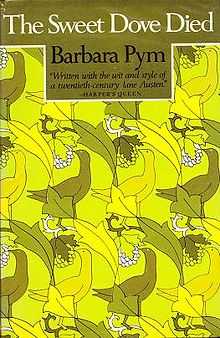The Sweet Dove Died

The Sweet Dove Died is a novel by Barbara Pym, first published in 1978. The title is a quotation from a poem, "I Had a Dove", by John Keats.
The novel was begun during the 1960s, after Pym's previous novel, An Unsuitable Attachment, had been rejected by several publishers. The Sweet Dove Died was also rejected, and Pym substantially rewrote it after her friend Philip Larkin suggested improvements. It was not, however, published until after her "comeback" of the late 1970s.
The plot is generally believed to have been inspired by Pym's brief romance with an American antique dealer, Richard Roberts, known to his friends as "Skipper".[1]
Synopsis
Leonora Eyre, an attractive and elegant, but essentially selfish, middle-aged woman, becomes friendly with antique dealer Humphrey Boyce and his nephew James. Both men are attracted to Leonora, but Leonora prefers the young, good-looking James to the more "suitable" Humphrey. While James is away on a buying trip, Leonora discovers to her annoyance that he has been seeing Phoebe, a girl of his own age. Leonora makes use of Humphrey to humiliate Phoebe, and turns out a sitting tenant in order that James can take up a flat in her own house. She does this in an apparent attempt to control his life. While abroad, the bisexual James has begun a relationship with an American, the amoral Ned, who later follows him to London. Ned prises James out of Leonora's grasp, only to reject him for another lover. James attempts a reconciliation with Leonora, but she refuses to give him a second opportunity to hurt her, and settles for the admiration of the less attractive Humphrey.
As with all Pym's fiction, the novel contains many literary references, notably to works by Keats, John Milton and Henry James.
Critical response
The book was widely praised by critics, with some exceptions. Many long-standing Pym readers were disappointed by the less overtly comic tone of the book, compared with her earlier novels. However, it is generally recognised as one of her best-constructed and most mature works.[2]
References
- ↑ K B Heberlein, "Barbara Pym", in Contemporary Literature, Vol. 26, No. 3, Autumn 1985
- ↑ Barbara Pym Society